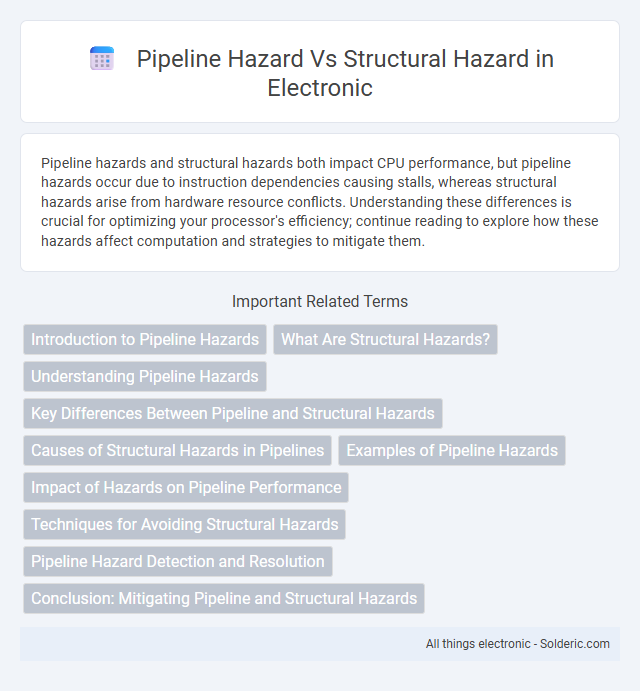Pipeline hazards and structural hazards both impact CPU performance, but pipeline hazards occur due to instruction dependencies causing stalls, whereas structural hazards arise from hardware resource conflicts. Understanding these differences is crucial for optimizing your processor's efficiency; continue reading to explore how these hazards affect computation and strategies to mitigate them.
Comparison Table
| Aspect | Pipeline Hazard | Structural Hazard |
|---|---|---|
| Definition | Situations that stall the pipeline due to data, control, or resource conflicts. | Conflicts arising from hardware resource limitations causing instruction delays. |
| Cause | Data dependencies, control flow changes, or instruction resource conflicts. | Insufficient hardware units (e.g., ALUs, memory ports) for concurrent instructions. |
| Type of Hazard | Includes data hazards, control hazards, and structural hazards. | A specific subset of pipeline hazards related to hardware resource conflicts. |
| Impact | Pipeline stalls, reduced instruction throughput, and latency increases. | Pipeline stalls due to hardware contention; limits parallelism. |
| Mitigation | Techniques such as forwarding, reordering, branch prediction. | Hardware duplication, resource allocation, or pipeline redesign. |
| Example | RAW (Read After Write) dependency causing stall in instruction fetch. | Two instructions requiring the same ALU in one clock cycle. |
Introduction to Pipeline Hazards
Pipeline hazards occur when the sequential flow of instructions in a processor is disrupted, causing delays or incorrect execution. Structural hazards specifically arise from hardware resource conflicts when multiple instructions need the same hardware component simultaneously. Understanding and mitigating these hazards is critical for optimizing CPU pipeline efficiency and improving overall processing speed.
What Are Structural Hazards?
Structural hazards occur in pipelined processors when hardware resources are insufficient to support all concurrent instructions, causing delays. Unlike pipeline hazards related to data or control dependencies, structural hazards arise from the physical unavailability of components like functional units or memory ports. Understanding these hazards helps you optimize processor design to avoid resource conflicts and improve instruction throughput.
Understanding Pipeline Hazards
Pipeline hazards occur when the next instruction cannot execute in the following clock cycle, causing delays in instruction processing. Structural hazards arise from resource conflicts when hardware units, such as ALUs or memory, are insufficient to support concurrent instruction execution. Understanding these hazards helps you optimize CPU pipeline design for efficient performance and reduced stalls.
Key Differences Between Pipeline and Structural Hazards
Pipeline hazards occur when instructions in a CPU pipeline interfere with each other, causing delays in instruction execution due to data dependencies or control flow changes. Structural hazards specifically arise from hardware resource conflicts when multiple instructions simultaneously require the same resource, such as memory or functional units. Your understanding of pipeline hazards involves dynamic scheduling techniques, while resolving structural hazards often necessitates additional hardware or resource duplication.
Causes of Structural Hazards in Pipelines
Structural hazards in pipelines occur due to resource conflicts when multiple instructions simultaneously require the same hardware component, such as a single memory port or functional unit. These hazards are caused by insufficient hardware replication or overlapping instruction stages competing for limited resources. Common examples include limited ALUs, single register files, or bottlenecks in memory access units that prevent concurrent instruction execution.
Examples of Pipeline Hazards
Pipeline hazards occur when instruction execution in a CPU pipeline is disrupted, causing delays or stalls. Common examples include data hazards, where instructions depend on the results of previous instructions not yet completed, control hazards caused by branch instructions altering the flow unpredictably, and structural hazards which arise when hardware resources like functional units or memory ports are insufficient to handle concurrent instruction demands. Understanding these hazards is crucial for optimizing CPU pipeline performance and minimizing instruction execution stalls.
Impact of Hazards on Pipeline Performance
Pipeline hazards significantly degrade pipeline performance by causing stalls and delays that reduce instruction throughput. Structural hazards occur when hardware resources are insufficient to support concurrent pipeline stages, leading to resource conflicts and pipeline stalls. Data and control hazards also disrupt pipeline flow by forcing instruction re-fetch or data forwarding, ultimately lowering execution efficiency and increasing cycles per instruction (CPI).
Techniques for Avoiding Structural Hazards
Techniques for avoiding structural hazards include resource duplication, where multiple functional units such as ALUs or memory ports are added to support simultaneous operations. Implementing pipeline interlocking mechanisms can stall instructions until required resources become available, preventing conflicts. Another approach is dynamic scheduling, which reorganizes instruction execution order to bypass resource contention and enhance throughput.
Pipeline Hazard Detection and Resolution
Pipeline hazard detection involves identifying conflicts in instruction execution stages that can cause delays or data corruption, typically using hardware mechanisms like forwarding, stalls, or hazard detection units. Structural hazards arise when hardware resources are insufficient to support concurrent instruction execution, requiring dynamic resource allocation or pipeline stalling to resolve. Effective resolution of pipeline hazards relies on forwarding paths to minimize stalls, hazard detection units to insert bubbles or nop instructions, and careful pipeline design to prevent structural resource conflicts.
Conclusion: Mitigating Pipeline and Structural Hazards
Mitigating pipeline and structural hazards requires a combination of hardware and software techniques, such as pipeline stall insertion, forwarding, and dynamic scheduling. Structural hazards, caused by resource conflicts, can be minimized by duplicating functional units or optimizing resource allocation. Your system's performance improves significantly when these strategies are employed to ensure smooth instruction flow and reduce pipeline stalls.
Pipeline hazard vs Structural hazard Infographic

 solderic.com
solderic.com